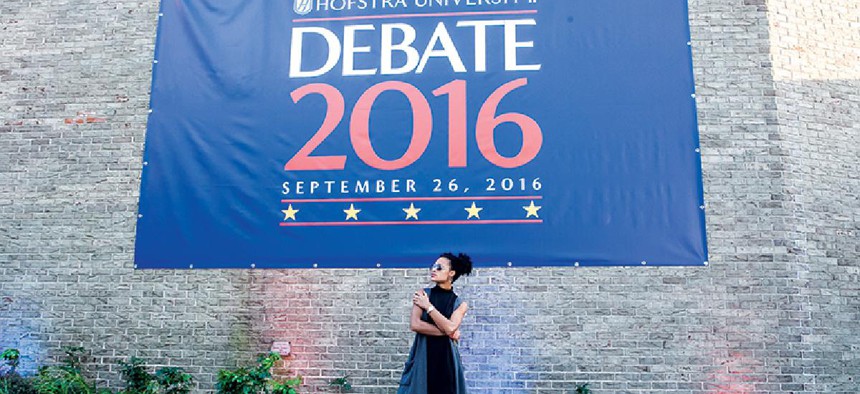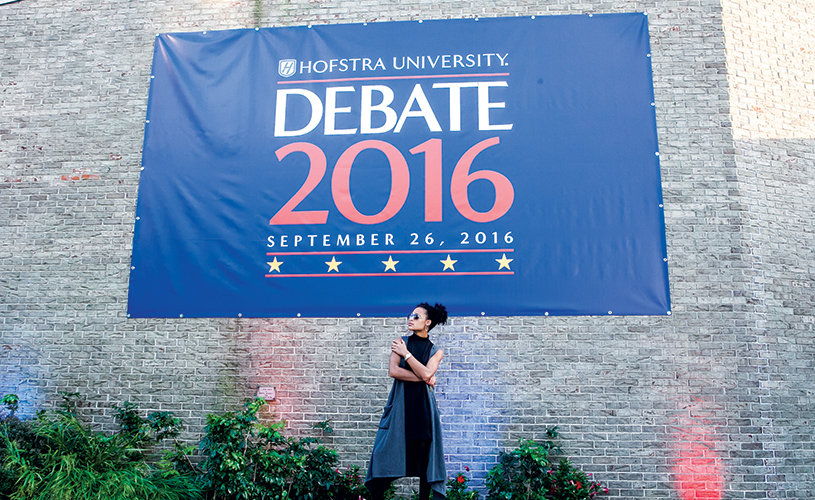
Photo by Marisol Diaz
Hillary Clinton was widely viewed as getting the better of Donald Trump in the first presidential debate of the 2016 general election, but the former first lady, New York senator and secretary of state wasn’t the only winner. Hofstra University, a private institution in Nassau County, had the distinction of hosting the historic debate – and also set a mark by having a presidential debate on its campus three cycles in a row. City & State’s Jon Lentz spoke with Hofstra University President Stuart Rabinowitz about the debate, its impact on the university and the Cuomo administration’s record on economic development.
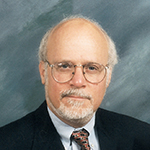
Hofstra University President
Stuart Rabinowitz
C&S: There has been plenty of commentary on how the first presidential debate went. From your perspective as the host, how did it go?
SR: It was perfect. I thought it was fabulous. The students have been energized since they found out that we were going to be the host this time, which was not too long ago. We had run some pre-debate programs, as we always do, discussing the issues. We had Eugene Robinson, Steve Hayes, David Axelrod and Bobby Jindal and different programs around the campus. Those programs were packed! You could just sense then that there was a buzz in the air and everybody was excited. It’s the students that matter, so we do this for our students. It was like a huge political tailgate party. On the day of the debate, students were out early in the morning and discussing things and cheering and even cheered me when I walked to the CNN set on campus, and that’s odd for college students to cheer their president. There was just so much excitement that it was a huge success for our students. And our students got tons of compliments from everybody involved for being helpful and polite and not rowdy and civilly discussing different sides of the same issue.
C&S: How many journalists were on campus?
SR: In the last debate in 2012, I think we gave out someplace between 3,000 and 3,500 media credentials. For this debate, I believe we gave out 5,000 media credentials. We have this huge gym which we turned into the media center, and it wasn’t big enough! So we had to let the media use the auditorium in our new medical school to have a place to sit. The other thing was a much larger contingent of foreign media than I’ve ever seen at any of these debates. They’re from all over Europe, Asia, Vietnam, Korea, China, all over. This was a great branding opportunity for the university by showing off its students at an important event not just in the United States but around the world.
C&S: Hofstra has its Peter Kalikow Center for the Study of the American Presidency. What role does that play in the debates?
SR: This is the third time we’ve done it, and in 2008, the first time, we made them aware in our application that we have a history of specializing in the American presidency. The university has done major conferences beginning in the FDR administration and going all the way through George W. Bush, so they knew we wanted this not just as an advertising thing, that this was part of one of our academic niches, so I think that helped. Interestingly enough, once they came, it motivated Peter Kalikow to help out and give us more recognition in this. There was the Kalikow Center for the Study of the American Presidency, which came right around the first debate, and then there was a professorship in the presidency, and just this fall Peter endowed a separate school of government, public policy and international relations. The rest of it was because we did such a good job the first time.
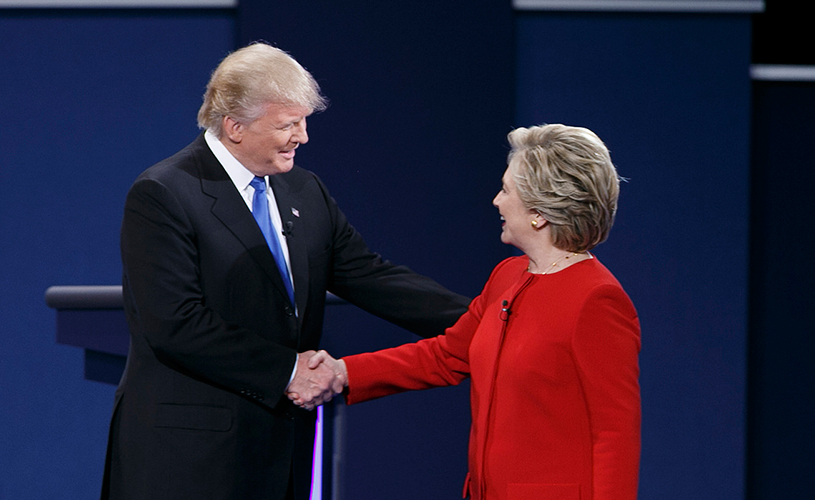
Photo by Jonathan Heisler / Hofstra University Photographer
The first presidential debate between Hillary Clinton and Donald Trump was held last week at Hofstra University on Long Island, and New York wasn’t just playing host – at times, it took center stage. The event attracted busloads of demonstrators to the Hofstra campus and drew millions of viewers for the first big face-to-face showdown between the two major-party candidates. City & State was out on Long Island too, photographing the sights and sounds of one of the biggest political events of the year.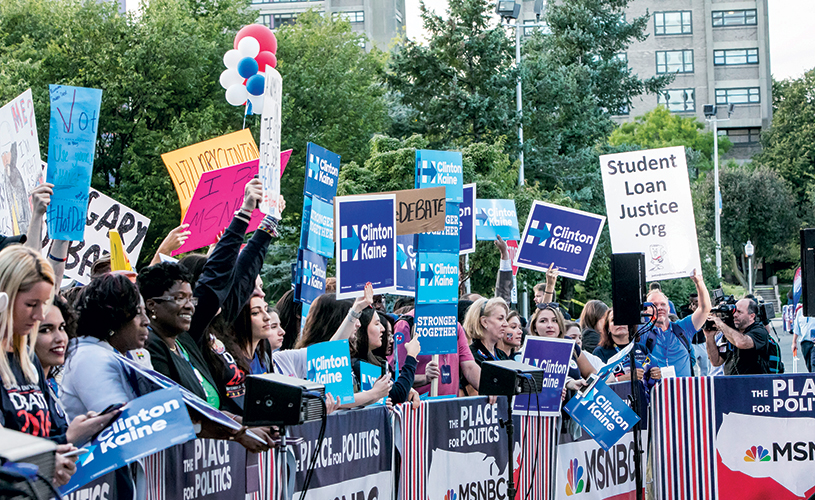
Photo by Marisol Diaz
Students cheer at the presidential debate between Hillary Clinton and Donald Trump at Hofstra University in Hempstead, NY on Sept. 27, 2016.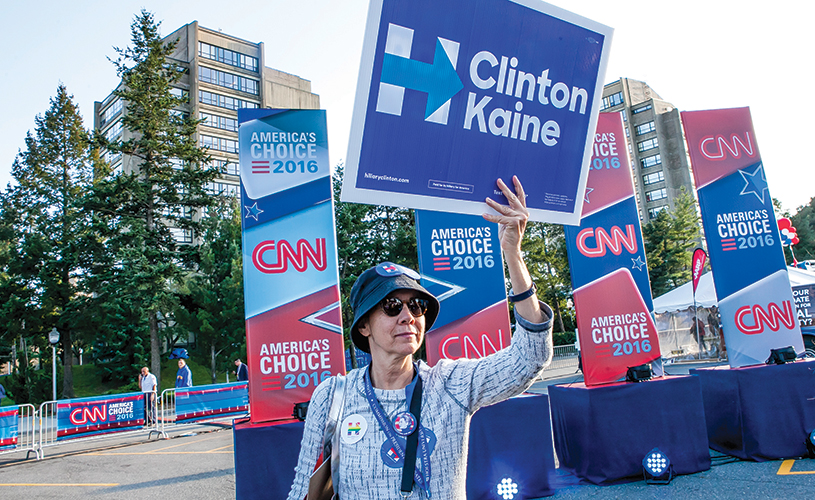
Photo by Marisol Diaz
Pro Clinton supporter Debo Gaffaney of Manhattan stands near the CNN site at the presidential debate between Hillary Clinton and Donald Trump at Hofstra University.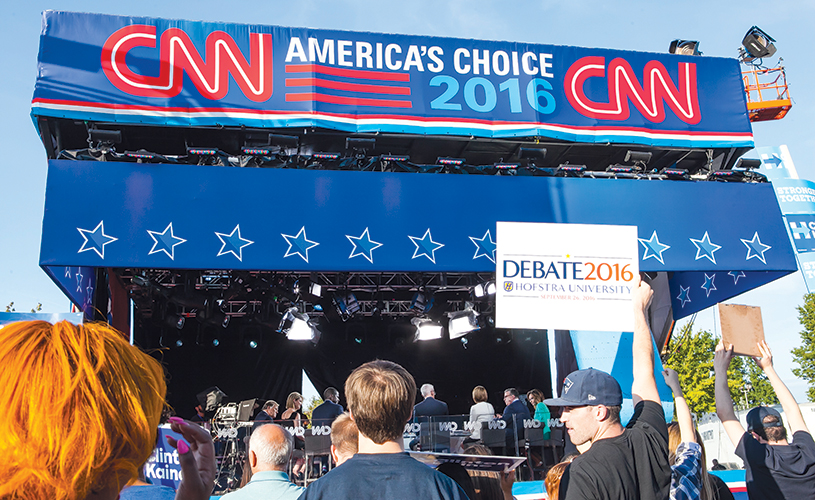
Photo by Marisol Diaz
The CNN coverage stage at the presidential debate at Hofstra University.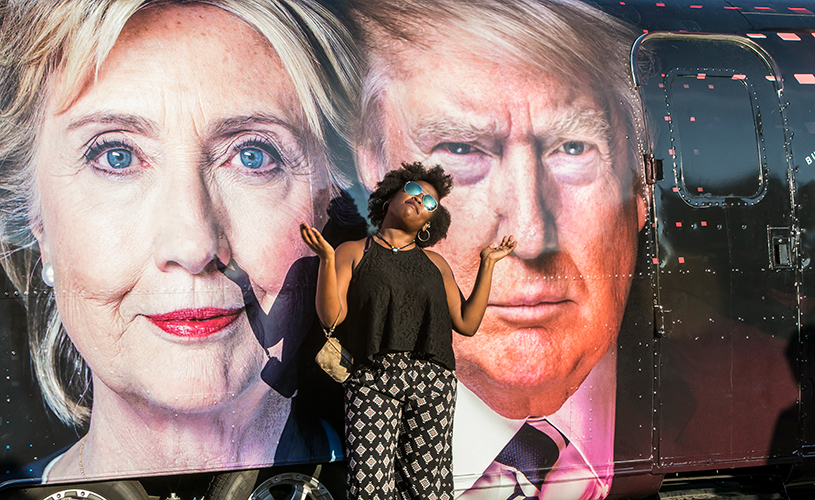
Photo by Marisol Diaz
Yasmin Wamala, a senior at Hofstra University, poses for a quick pic at the presidential debate between Hillary Clinton and Donald Trump.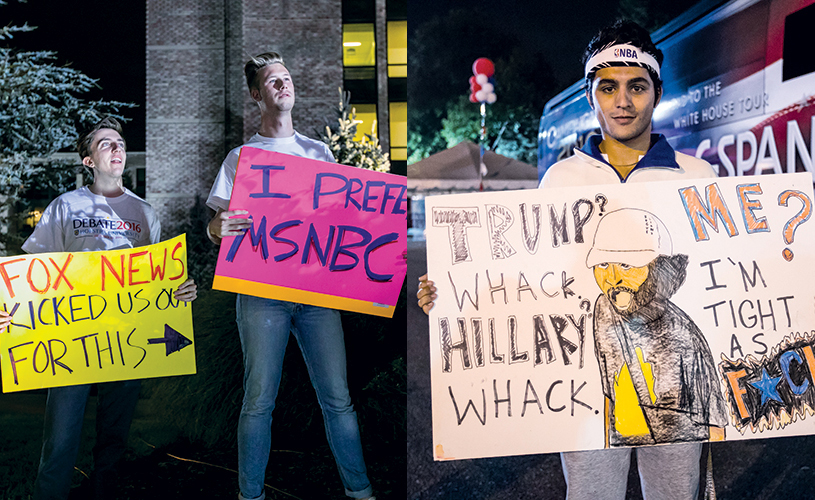
Photo by Marisol Diaz
(Left) Kenneth Hanlon, a junior, and Kenton Scott at Hofstra University stand with their posters near the location for the FOX telecast.
(Right) Marco Rubero, a freshman at Hofstra University, is not voting for either candidate as he stands with his poster at the presidential debate.
C&S: Hofstra was the first institution to host a debate three times in a row. Have enrollment applications gone up as a result?
SR: The three times really matters. When you have an event that draws a lot of attention, it’s not unusual to get a bump in applications the following year. It’s also not unusual for it to go back to normal. But somebody once referred to us as “Debate U.” Branding is a longtime thing, you need a lot of patience to get the world to understand how good you really are. We sit here and we think, “gee, we’re going great.” But none of that matters unless a lot of people agree with us. So three in a row is no fluke. It’s not a one-time show. It’s not like you win the basketball once and next year all your seniors graduate. It’s a long time for us to be in the center of presidential elections. So I’m really proud and pleased and pretty optimistic that it will have a long-term branding effect. With better credentials, students from around the world over time will look at Hofstra differently because of all three of these. It’s much better than your traditional advertising where you yourself say, “hey, I’m great,” and then have to pay for this. Everybody recognizes how important this event was, and that’s the branding: Really important events happen at Hofstra University.
C&S: Do you anticipate applying to host a debate in 2020?
SR:Right now, everybody on campus is so tired. Everybody’s helping to clean up and break down equipment. So right now it seems like, gee, I don’t know. I’d have to think about that. We’ll have to see.
C&S: Hofstra was initially a backup host. How did you find out that you’d be getting a debate this year? Were you surprised?
SR: I was very surprised. I got an email from the Commission on Presidential Debates which said, “When convenient, give us a call. Nothing urgent.” It was in the late afternoon in the middle of July, and I said to myself, “that’s odd.” I figured they probably wanted to ask one of our people who are really experienced to go out and help maybe Wright State or something like that. Looking at the email, I did not believe that we would actually be the host. So I called up and found out that Wright State was going to withdraw and we had promised to be the alternate. When you apply for a presidential debate, you have to promise that whatever you get you will accept. We were selected as the alternate a year ago. Every day that went by and I didn’t hear anything, I thought, “OK, better luck next time.” So I was surprised, but really thrilled. I’m not sure another school could have done it in 80 days. We were the go-to school on short notice.
C&S: You have worked with Gov. Andrew Cuomo on economic development as co-chairman of the Long Island Regional Economic Development Council. Does the recent criminal complaint by U.S. Attorney Preet Bharara on the state’s Buffalo investments give you any pause in how the Cuomo administration has worked with you and others in your region?
SR: I have seen nothing but integrity, goodwill and principled decision-making. It’s not like the council is close to the governor, although I admire him for coming up with this idea of REDCs. We do our thing on Long Island and work with the local ESD people who are terrific, and we compete with the other 10 regions and then we await the decision. Look, we won four out of five times, so we think they make very wise decisions. I have no second thoughts about it. I think it has drawn together Nassau and Suffolk in a way that I’ve never seen before. Nobody likes to see potential corruption in government, but that doesn’t have impact down here.

